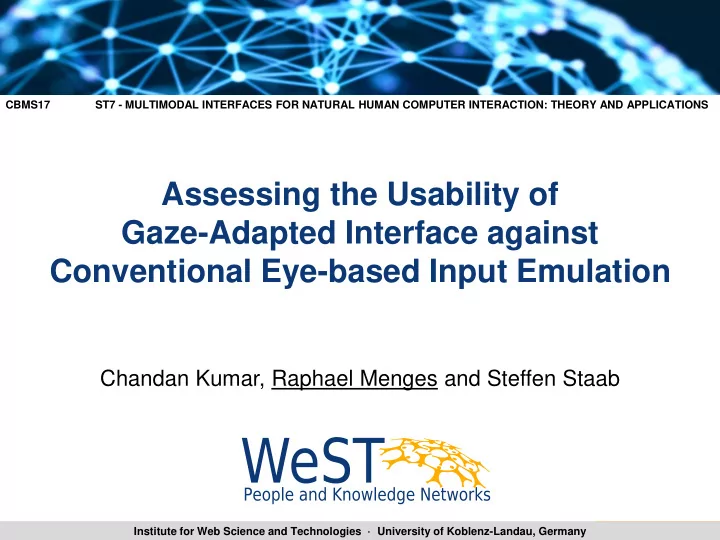

CBMS17 ST7 - MULTIMODAL INTERFACES FOR NATURAL HUMAN COMPUTER INTERACTION: THEORY AND APPLICATIONS Assessing the Usability of Gaze-Adapted Interface against Conventional Eye-based Input Emulation Chandan Kumar, Raphael Menges and Steffen Staab Institute for Web Science and Technologies · University of Koblenz-Landau, Germany
Motivation • Social platforms are an opportunity for physically impaired people to connect with others • Eye gaze tracking is an emerging input device • Two interface approaches to include eye gaze – Emulation of traditional input devices – Gaze-adapted interface Research Question: What is the impact on Usability and Task Load for the user? 2 Assessing the Usability of Gaze-Adapted Interface against Conventional Eye-based Input Emulation
Assessment of Usability Emulation 1 1 OptiKey Software and Firefox, showing mobile Twitter page Gaze-Adapted Twitter 3 Assessing the Usability of Gaze-Adapted Interface against Conventional Eye-based Input Emulation
Eye Tracking There are two major challenges 1 for eye tracking • Limited Accuracy • Maximal accuracy is one degree due eye geometry • Calibration drift through head movements Gaze Fixation → Size and position of interface elements • Midas Touch • Eye is both sensor and controller → Dwell time based interaction Fixation Idle 1 Kumar, C., Menges, R., & Staab, S. (2016). Eye-Controlled Interfaces for Multimedia Interaction. IEEE Multimedia, 23(4), 6-13. 4 Assessing the Usability of Gaze-Adapted Interface against Conventional Eye-based Input Emulation
Emulation of traditional input devices • Emulation of mouse and keyboard using gaze • Dwell time based button interaction • Example of left mouse button click Dwell on left mouse click button → Dwell on click area → Magnification of area and another dwell on exact position Example application: https://github.com/OptiKey/OptiKey 5 Assessing the Usability of Gaze-Adapted Interface against Conventional Eye-based Input Emulation
Gaze-adapted Twitter • Content Area displays recent tweets and provides no interaction • Action Bar provides contextual actions by dwell time buttons 6 Assessing the Usability of Gaze-Adapted Interface against Conventional Eye-based Input Emulation
Gaze-adapted Twitter: Demo 7 Assessing the Usability of Gaze-Adapted Interface against Conventional Eye-based Input Emulation
Experimental Setup • Hardware • Task – Tobii EyeX consumer eye – Write a tweet and publish it, find a tracking device particular user and follow her, find • Software and like a certain tweet. Explore the application (5-10 min) – Our gaze-adapted Twitter • Participants application – OptiKey operating Firefox – 13 students (10M, 3F), aged with mobile Twitter page between 20 and 39 • Study – Learning: Eye tracking tutorial provided by Tobii executed – Think-aloud study, including SUS and NASA-TLX survey – Counter-balancing between the two softwares performed 8 Assessing the Usability of Gaze-Adapted Interface against Conventional Eye-based Input Emulation
Results: System Usability Score 100 80 SUS Average 1 60 Better = 68 40 20 0 P1 P2 P3 P4 P5 P6 P7 P8 P9 P10 P11 P12 P13 Gaze-adapted T witter OptiKey (Mobile T witter) Mean = 72 Mean = 50 p =.0044 < 5% 1 https://measuringu.com/sus 9 Assessing the Usability of Gaze-Adapted Interface against Conventional Eye-based Input Emulation
Results: Task Load Average Raw Score 100 Gaze-adapted Twitter Mean = 47 OptiKey (Mobile Twitter) Mean = 64 80 Better 60 40 20 0 Mental Physical Temporal Perfor- Effort Frustration Demand Demand Demand mance p =.0238 < 5% 10 Assessing the Usability of Gaze-Adapted Interface against Conventional Eye-based Input Emulation
Results: Task Load Average Weightings Gaze-adapted Twitter OptiKey (Mobile Twitter) 0.25 0.20 Providing the 0.15 importance of the values 0.10 0.05 0.00 Mental Physical Temporal Perfor- Effort Frustration Demand Demand Demand mance • Frustration weighting being two times higher for the emulation • Mental demand , effort and frustration were judged as the most relevant scales by the participants 11 Assessing the Usability of Gaze-Adapted Interface against Conventional Eye-based Input Emulation
Results: Task Load Average Raw Score 100 Gaze-adapted Twitter OptiKey (Mobile Twitter) 80 60 Better 40 20 0 Mental Physical Temporal Perfor- Effort Frustration Demand Demand Demand mance Pairwise weighting indicates importance! 12 Assessing the Usability of Gaze-Adapted Interface against Conventional Eye-based Input Emulation
Observations • Participants felt stressed when the interface reacted constantly to their gaze • Users are very focused on the visual search task and overlook system’s help (e.g., auto text suggestions while typing) • Participants prefer the option to personalize the interaction with respect to their experience 13 Assessing the Usability of Gaze-Adapted Interface against Conventional Eye-based Input Emulation
Conclusion • Gaze-adapted interface for Twitter was presented • Evaluation showed an advantage in both usability and mental demand for gaze-adapted interface over emulation approach • Future Work: We implement and evaluate Web browsing with eyes and mind , for gaze-adaption of various service interfaces Chandan Kumar, Raphael Menges and Steffen Staab Thank you for your Attention! This work is part of project MAMEM that has received funding from the European Union's Horizon 2020 research and innovation program under grant agreement number: 644780. Institute for Web Science and Technologies · University of Koblenz-Landau, Germany
Recommend
More recommend